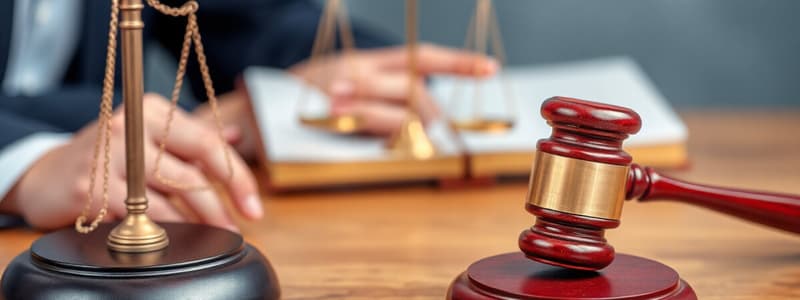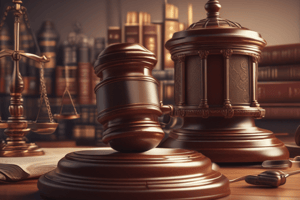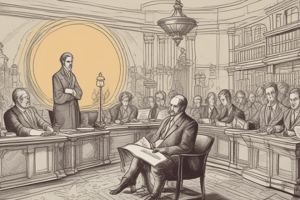Podcast
Questions and Answers
What is the consequence of a company being registered at companies house?
What is the consequence of a company being registered at companies house?
In which case was the corporate veil successfully pierced?
In which case was the corporate veil successfully pierced?
What must occur for a person to be relieved of liability for a pre-incorporation contract?
What must occur for a person to be relieved of liability for a pre-incorporation contract?
Which section of the Companies Act 2006 relates to the incorporation of a company?
Which section of the Companies Act 2006 relates to the incorporation of a company?
Signup and view all the answers
What happens to the liability of subscribers once a company is incorporated?
What happens to the liability of subscribers once a company is incorporated?
Signup and view all the answers
What is a key requirement for the memorandum of association post-CA 2006?
What is a key requirement for the memorandum of association post-CA 2006?
Signup and view all the answers
Which of the following documents is NOT included in a company's constitution according to S17?
Which of the following documents is NOT included in a company's constitution according to S17?
Signup and view all the answers
What role do articles of association play in a company?
What role do articles of association play in a company?
Signup and view all the answers
Under what condition can model articles be modified within a company's articles of association?
Under what condition can model articles be modified within a company's articles of association?
Signup and view all the answers
What is the primary purpose of shareholder agreements?
What is the primary purpose of shareholder agreements?
Signup and view all the answers
Which of the following statements regarding the effect of a company’s constitution is accurate?
Which of the following statements regarding the effect of a company’s constitution is accurate?
Signup and view all the answers
What can be concluded about the articles of association and the directors’ powers?
What can be concluded about the articles of association and the directors’ powers?
Signup and view all the answers
What is a requirement for the breach of articles of association to be actionable by a member against a director?
What is a requirement for the breach of articles of association to be actionable by a member against a director?
Signup and view all the answers
How can entrenchment in articles of association primarily be described?
How can entrenchment in articles of association primarily be described?
Signup and view all the answers
What is the primary outcome of a certificate of incorporation?
What is the primary outcome of a certificate of incorporation?
Signup and view all the answers
According to the Companies Act 2006, what power does a general meeting hold regarding directors?
According to the Companies Act 2006, what power does a general meeting hold regarding directors?
Signup and view all the answers
What must shareholders do if they wish to change a limitation on their powers as outlined in the Articles of Association?
What must shareholders do if they wish to change a limitation on their powers as outlined in the Articles of Association?
Signup and view all the answers
What is a significant limitation on shareholders' power detailed in the articles of association?
What is a significant limitation on shareholders' power detailed in the articles of association?
Signup and view all the answers
In the case of Automatic Self-cleansing filter syndicate co ltd v Cuninghame, what did the court rule regarding the directors' response to the ordinary resolution passed by shareholders?
In the case of Automatic Self-cleansing filter syndicate co ltd v Cuninghame, what did the court rule regarding the directors' response to the ordinary resolution passed by shareholders?
Signup and view all the answers
Which of the following is a fundamental aspect of distributing decision-making power within a company?
Which of the following is a fundamental aspect of distributing decision-making power within a company?
Signup and view all the answers
If shareholders pass a resolution directing the board to take a specific action, under what condition must the board comply?
If shareholders pass a resolution directing the board to take a specific action, under what condition must the board comply?
Signup and view all the answers
In the context of breaches arising from articles of association, what is true regarding the pursuit of claims?
In the context of breaches arising from articles of association, what is true regarding the pursuit of claims?
Signup and view all the answers
What is indicated by case law regarding the relationship between directors and shareholders?
What is indicated by case law regarding the relationship between directors and shareholders?
Signup and view all the answers
What is an essential feature of the Model Articles regulations 2008 regarding directors' authority?
What is an essential feature of the Model Articles regulations 2008 regarding directors' authority?
Signup and view all the answers
What does the term 'quorum' refer to in the context of company meetings?
What does the term 'quorum' refer to in the context of company meetings?
Signup and view all the answers
What does the term 'negative resolution' refer to in shareholder meetings?
What does the term 'negative resolution' refer to in shareholder meetings?
Signup and view all the answers
In John Shaw & Sons (Salford) Ltd v Shaw, what did the court rule regarding shareholders directing the board to discontinue legal proceedings?
In John Shaw & Sons (Salford) Ltd v Shaw, what did the court rule regarding shareholders directing the board to discontinue legal proceedings?
Signup and view all the answers
Under what circumstance may members exercise the power of the board, according to the content?
Under what circumstance may members exercise the power of the board, according to the content?
Signup and view all the answers
If a company's board of directors is evenly split on a crucial decision, what is their recourse according to the governing principles?
If a company's board of directors is evenly split on a crucial decision, what is their recourse according to the governing principles?
Signup and view all the answers
What is the effect of a limitation on members' powers as specified in the Articles of Association?
What is the effect of a limitation on members' powers as specified in the Articles of Association?
Signup and view all the answers
The incorporation of a company does not create a separate legal entity.
The incorporation of a company does not create a separate legal entity.
Signup and view all the answers
In the case of Gilford v Motor Co Ltd, the court successfully pierced the corporate veil.
In the case of Gilford v Motor Co Ltd, the court successfully pierced the corporate veil.
Signup and view all the answers
Under S51 CA 2006, a company can ratify pre-incorporation contracts after its registration.
Under S51 CA 2006, a company can ratify pre-incorporation contracts after its registration.
Signup and view all the answers
Only two cases successfully pierced the corporate veil in legal history.
Only two cases successfully pierced the corporate veil in legal history.
Signup and view all the answers
Subscribers to the memorandum remain personally liable once a company is incorporated.
Subscribers to the memorandum remain personally liable once a company is incorporated.
Signup and view all the answers
A company can only be formed by natural persons and cannot include legal persons.
A company can only be formed by natural persons and cannot include legal persons.
Signup and view all the answers
The memorandum of association is included in a company's constitution according to the Companies Act 2006.
The memorandum of association is included in a company's constitution according to the Companies Act 2006.
Signup and view all the answers
Articles of association serve as a binding contract between the company and its members.
Articles of association serve as a binding contract between the company and its members.
Signup and view all the answers
Shareholder agreements can cover every detail outlined within the articles of association.
Shareholder agreements can cover every detail outlined within the articles of association.
Signup and view all the answers
Model Articles cannot be changed unless they contradict the Companies Act 2006.
Model Articles cannot be changed unless they contradict the Companies Act 2006.
Signup and view all the answers
A significant aspect of the memorandum of association prior to CA 2006 included lists of objects that a company could engage in.
A significant aspect of the memorandum of association prior to CA 2006 included lists of objects that a company could engage in.
Signup and view all the answers
The Companies Act 2006 allows for a single member company to have multiple shareholders.
The Companies Act 2006 allows for a single member company to have multiple shareholders.
Signup and view all the answers
A director being removed while also being a shareholder constitutes a breach of the articles.
A director being removed while also being a shareholder constitutes a breach of the articles.
Signup and view all the answers
The company's articles of association must be formally amended before limitations on members' power can be disregarded.
The company's articles of association must be formally amended before limitations on members' power can be disregarded.
Signup and view all the answers
Entrenchment provisions can increase a member's liability without their consent after the alteration.
Entrenchment provisions can increase a member's liability without their consent after the alteration.
Signup and view all the answers
The distribution of decision-making power in a company can be limited by the Companies Act 2006.
The distribution of decision-making power in a company can be limited by the Companies Act 2006.
Signup and view all the answers
A trading certificate is evidence that the company has not met the requirements of the Act regarding registration.
A trading certificate is evidence that the company has not met the requirements of the Act regarding registration.
Signup and view all the answers
Directors can be validly removed from office at a general meeting even if such action violates the company's articles.
Directors can be validly removed from office at a general meeting even if such action violates the company's articles.
Signup and view all the answers
A unanimous agreement of all shareholders can override any provision for entrenchment in the articles.
A unanimous agreement of all shareholders can override any provision for entrenchment in the articles.
Signup and view all the answers
A breach of articles by a single member can be pursued directly against that member.
A breach of articles by a single member can be pursued directly against that member.
Signup and view all the answers
The Model Articles regulations 2008 allow directors to exercise all powers of the company subject to the articles.
The Model Articles regulations 2008 allow directors to exercise all powers of the company subject to the articles.
Signup and view all the answers
Members can direct the board to make decisions without amending the company’s articles of association.
Members can direct the board to make decisions without amending the company’s articles of association.
Signup and view all the answers
If a company’s articles provide for the exclusive authority of directors, shareholders can still overrule a decision made by the board.
If a company’s articles provide for the exclusive authority of directors, shareholders can still overrule a decision made by the board.
Signup and view all the answers
In Barron v Potter, the court ruled that the power to conduct company affairs could not revert to the general meeting when the board cannot act.
In Barron v Potter, the court ruled that the power to conduct company affairs could not revert to the general meeting when the board cannot act.
Signup and view all the answers
A resolution passed at a shareholders' meeting can compel the directors to sell company assets regardless of the articles’ stipulations.
A resolution passed at a shareholders' meeting can compel the directors to sell company assets regardless of the articles’ stipulations.
Signup and view all the answers
If a quorum is not met for a board meeting, the existing directors can still make binding decisions.
If a quorum is not met for a board meeting, the existing directors can still make binding decisions.
Signup and view all the answers
In the case of John Shaw & Sons, the court found that shareholders could take over management powers by simply passing a resolution.
In the case of John Shaw & Sons, the court found that shareholders could take over management powers by simply passing a resolution.
Signup and view all the answers
A group of shareholders representing a simple majority can change a company's articles of association without a special resolution.
A group of shareholders representing a simple majority can change a company's articles of association without a special resolution.
Signup and view all the answers
The principle established by Automatic Self-cleansing filter syndicate co ltd v Cuninghame confirms that directors must follow majority shareholder resolutions.
The principle established by Automatic Self-cleansing filter syndicate co ltd v Cuninghame confirms that directors must follow majority shareholder resolutions.
Signup and view all the answers
A resolution can compel directors to reverse a strategic decision if the shareholders hold a majority stake in the company.
A resolution can compel directors to reverse a strategic decision if the shareholders hold a majority stake in the company.
Signup and view all the answers
Flashcards
Company Incorporation
Company Incorporation
The legal process of forming a company, creating a separate legal entity under the Companies Act 2006.
Separate Legal Personality
Separate Legal Personality
A company is a separate legal entity from its owners (shareholders), so that owners are not personally liable for company debts.
Corporate Veil
Corporate Veil
The legal concept that protects shareholders from personal liability for company debts.
Piercing the Corporate Veil
Piercing the Corporate Veil
Signup and view all the flashcards
Pre-incorporation Contracts
Pre-incorporation Contracts
Signup and view all the flashcards
Company Registration
Company Registration
Signup and view all the flashcards
Memorandum of Association (pre-2006)
Memorandum of Association (pre-2006)
Signup and view all the flashcards
Memorandum of Association (post-2006)
Memorandum of Association (post-2006)
Signup and view all the flashcards
Articles of Association
Articles of Association
Signup and view all the flashcards
Shareholder Agreements
Shareholder Agreements
Signup and view all the flashcards
Companies Act 2006 (s33)
Companies Act 2006 (s33)
Signup and view all the flashcards
Model Articles
Model Articles
Signup and view all the flashcards
Breach of articles of association
Breach of articles of association
Signup and view all the flashcards
Entrenchment (of articles)
Entrenchment (of articles)
Signup and view all the flashcards
Special resolution
Special resolution
Signup and view all the flashcards
Certificate of Incorporation
Certificate of Incorporation
Signup and view all the flashcards
Company Decision Making
Company Decision Making
Signup and view all the flashcards
Distribution of Power
Distribution of Power
Signup and view all the flashcards
Director's General Authority
Director's General Authority
Signup and view all the flashcards
Shareholder Reserve Power
Shareholder Reserve Power
Signup and view all the flashcards
Members' Power Limits
Members' Power Limits
Signup and view all the flashcards
Board's Decision-Making Power
Board's Decision-Making Power
Signup and view all the flashcards
Changing the Articles
Changing the Articles
Signup and view all the flashcards
Directors vs. Agents
Directors vs. Agents
Signup and view all the flashcards
Members' Power in Deadlock
Members' Power in Deadlock
Signup and view all the flashcards
Quorum Meaning
Quorum Meaning
Signup and view all the flashcards
Barron v Potter
Barron v Potter
Signup and view all the flashcards
MA 11 (Companies Act 2006)
MA 11 (Companies Act 2006)
Signup and view all the flashcards
Example: Nia Ltd's Article of Asssociation
Example: Nia Ltd's Article of Asssociation
Signup and view all the flashcards
Novation
Novation
Signup and view all the flashcards
Company Formation
Company Formation
Signup and view all the flashcards
Company Constitution: What's Required?
Company Constitution: What's Required?
Signup and view all the flashcards
Memorandum of Association: Before 2006
Memorandum of Association: Before 2006
Signup and view all the flashcards
Memorandum of Association: After 2006
Memorandum of Association: After 2006
Signup and view all the flashcards
Articles of Association: Company Rulebook
Articles of Association: Company Rulebook
Signup and view all the flashcards
Shareholder Agreements: Beyond the Rules
Shareholder Agreements: Beyond the Rules
Signup and view all the flashcards
Breach of Articles by Members
Breach of Articles by Members
Signup and view all the flashcards
How to Pursue a Breach of Articles
How to Pursue a Breach of Articles
Signup and view all the flashcards
Amending the Articles
Amending the Articles
Signup and view all the flashcards
Entrenchment
Entrenchment
Signup and view all the flashcards
How is Entrenchment Achieved?
How is Entrenchment Achieved?
Signup and view all the flashcards
Decision Making Power in Companies
Decision Making Power in Companies
Signup and view all the flashcards
Decision Making Organs
Decision Making Organs
Signup and view all the flashcards
Default Power Allocation: Model Articles
Default Power Allocation: Model Articles
Signup and view all the flashcards
Members' Power Limitations
Members' Power Limitations
Signup and view all the flashcards
Can members overrule board decisions?
Can members overrule board decisions?
Signup and view all the flashcards
Are directors agents of members?
Are directors agents of members?
Signup and view all the flashcards
Members' power limits in articles
Members' power limits in articles
Signup and view all the flashcards
What happens in a board deadlock?
What happens in a board deadlock?
Signup and view all the flashcards
Quorum: What does it mean?
Quorum: What does it mean?
Signup and view all the flashcards
Barron v Potter case
Barron v Potter case
Signup and view all the flashcards
MA 11: What is it?
MA 11: What is it?
Signup and view all the flashcards
Study Notes
Company Incorporation
- Separate Legal Personality: Company registration transforms subscribers into shareholders, creating a separate legal entity with its own rights, obligations, and duties. This is an inevitable consequence of incorporation.
- Salomon v Salomon & Co. Ltd. (1897): This case established the "corporate veil," meaning a company is a distinct legal entity separate from its owners. Shareholders have limited liability.
- Piercing the Corporate Veil: Courts can disregard the corporate veil in exceptional situations, holding shareholders personally liable. This is an exception to the general rule of limited liability. Notable cases include Gilford Motor Co Ltd and Jones v Lipman, showing successful piercing. Prest v Petrodel Resources was unsuccessful.
Pre-Incorporation Contracts
- Liability: A company cannot enter contracts before incorporation. Those entering pre-incorporation contracts are personally liable, unless novated or the other party agrees to termination.
- Section 51, Companies Act 2006: Legislation outlining the conditions for liability in pre-incorporation contracts. It highlights the non-existence of the company before formal registration.
Company Incorporation Process (Registration)
- Eligibility: Private companies can be incorporated by one or more natural or legal persons.
- Registration Location: Companies are registered at Companies House (executive agency of the Department for Business, Energy, and Industrial Strategy) in England, Wales, Northern Ireland, and Scotland.
- Registration Documents: The registrar requires the memorandum of association, articles of association (default are Model Articles of Association), application for registration, statement of company type, and a statement of compliance.
Memorandum of Association (Pre-2006 vs Post-2006)
- Pre-2006: A crucial constitutional document listing the company's objects. Exceeding these "objects" (ultra vires) could make transactions void and directors liable. Often extensive lists to allow flexibility.
- Post-2006: Section 8 defines the Memorandum—a document confirming the subscribers' intention to form a company and become members, with each taking at least one share. It must be in a prescribed format and authenticated. Section 17 clarifies the company's constitution, primarily consisting of articles of association, not the memorandum. Previous Memoranda are treated as provisions of articles.
Articles of Association
- Company Rulebook: Articles, a key part of the company's constitution, function as an internal rulebook outlining company operations and procedures. Publicly accessible.
- Default Rules: The Companies (Model Articles) Regulations 2008 provide default articles if none are specified. These articles cannot contradict the Companies Act 2006.
- Amendment: Articles can be amended by a special resolution of members (section 21, Companies Act 2006).
Shareholder Agreements
- Complementary Role: Shareholder agreements are private contracts among stakeholders, particularly useful for addressing nuances articles cannot cover. These contracts supplement the articles.
- Enforceability: Breaches of terms in a shareholder agreement can invite legal action by other shareholders.
Entrenchment and Minority Shareholders
- Protecting Minority Interests: Entrenchment, sometimes embedded in articles, can make certain clauses harder to alter, potentially safeguarding minority shareholders. Section 22 provides guidelines for this.
- Circumvention: Unanimous shareholder agreement or court order can override entrenchment provisions.
Certificate of Incorporation
- Conclusive Evidence: The certificate is conclusive evidence that the company's registration meets the Act's requirements.
Company Decision-Making
- Distinction Between Actions: Companies, as legal entities, act through their representatives (directors, officers, and agents). Differentiating company actions from those taken on the company's behalf is vital.
- Decision-Making Organs: The Articles of Association and the Companies Act 2006 allocate decision-making authority to the board of directors and general meetings of shareholders.
- Companies (Model Articles) Regulations 2008: Defines how directors exercise powers (MA 3). Shareholders' reserve power (MA 4) to direct actions, but not invalidate past actions.
- Overriding Articles: Members can't disregard article limitations or usurp board powers without formal amendment.
General Meetings and Resolutions
- Resolution Types: Ordinary resolutions require a simple majority (over 50%), while special resolutions need at least 75% approval.
- Duomatic Principle: All shareholders, ideally in writing or through consent where possible, can effectively enact decisions.
- Limitations: The Duomatic principle strictly requires agreement from all voting members. Consent must be demonstrably real and verifiable.
Board Meetings
- Power Distribution: The power allocation for company decision-making is in the Articles. The Company Act 2006 provides additional decision making powers
- Default rules: Default power distribution is defined by the Companies (Model Articles) Regulations 2008.
- Resolution Process: Model Articles often grant decision-making power to the board via a simple majority.
Removing Directors
- Procedure: Directors can be removed by a special resolution, but shareholders need to provide sufficient notice.
Changing Company Name
- Approval Method: Company name changes require special resolutions and compliance with stated articles.
Studying That Suits You
Use AI to generate personalized quizzes and flashcards to suit your learning preferences.
Description
This quiz explores the concept of company incorporation, focusing on the creation of separate legal personality and the implications of the corporate veil. It also examines pre-incorporation contracts and the liabilities involved. Test your knowledge of key cases and principles regarding corporate law.




